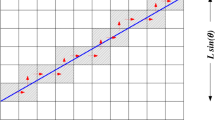Abstract
A stochastic model for the calculation of flow and contaminant transport in a single fracture with variable apertures was presented. The spatially varying apertures of the fracture were generated using a geostatistical method, based on a given aperture probability density distribution and a specified spatial correlation length. Fluid flowed between two points in the fracture plane. The fluid potential at each node of the discretization mesh was computed and the steady state flow rates between all the nodes were obtained. Then the contaminant transport was calculated using a particle tracking method. The migration plumes of contaminant between the inlet and the outlet were displayed in contour plots and contaminant elution profiles were also plotted. Calculations showed that fluid flow occured predominantly in a few preferred paths. Hence, the large range of apertures in the fracture gives rise to flow channeling. Simulation results were correlated with the basic input parameters: standard deviation of a lognormal aperture distribution function and the spatial correlation length.
Similar content being viewed by others
References
Bianchi, L. and Snow, D., “Permeability Crystalline Rock Interpretated from Measured Orientations and Apertures fo Fractures”,Annu. Arid Zone,8, 231 (1968).
Choi, H. J., Lee, H. S. and Han, K. W., “A Theoretical Study on the Migration of Radionuclides in a Radwaste Disposal System”,HWAHAK KONGHAK. 26, 229 (1988).
Desbarats, A. J., “Macrodispersion in Sand-Shale Sequences”,Water Resour. Res.,26, 153(1990).
El-Kadi, A. I., “Model Variability in Groundwater Flow”, International Groundwater Modeling Center, GWMI 84-10, Holcomb Research Institute, Butler Univ. (1984).
Keum, D. K., Cho, W. J., Hahn, P. S. and Park, H. H., “Study on the Radionuclide Migration Modeling for a Single Fracture In Geologic Media”,J. of Km. Nucl. Soc,26, 401(1994).
Lee, Y.M., Cho, W.J., Han, K. W. and Park, H.H., “Verification of a Nuclide Migration Model by Comparing with Other Models”,J. of the Kor. Nucl. Soc., 22, 304(1990).
Levenspiel, O., Chemical Reaction Engineering. 2nd ed., John Wiley, New York (1972).
Mantoglou, A. and Wilson, J. L., “The Turning Band Method for Simulation of Random Fields Using Line Generation by a Spectral Method”,Water Resour. Res.,18, 1379(1982).
Moreno, L., Neretnieks, I. and Eriksen, T., “Analysis of Some Laboratory Tracer Runs in Natural Fissures”,Water Resour. Res.,21, 951(1985).
Moreno, L. and Neretnieks, I., “Flow and Nuclide Transport in Fractured Media”,J. of Contaminant Hydrology,14, 163(1993).
Moreno. L., Tsang, C. F., Hale, F.V. and Neretnieks, I., “Flow and Tracer Transport in a Single Fracure”,Water Resour. Res.,24, 2033(1988).
Nash, J. C., “Compact Numerical Methods for Computers: Linear Algebra and Function Minimization”, John Wiley and Sons, New York (1979).
Neretnieks, I., Eriksen, T. and Tahtinen, T., “Tracer Movement in a Single Fissure in Granitic Rock”,Water Resour. Res.,18, 849 (1982).
Park, C. K., Vandergraaf, T. T., Drew, D. T. and Hahn, P. S., “Interpretation of Migration of Radionuclides in a Rock Fracture Using a Particle Tracking Method”,J. of Korean Nucl. Soc.,27. 176 (1995).
Smith, L. and Schwartz, F. W., “Mass Transport 1, A Stochastic Analysis of Macroscopic Dispersion”,Water Resour. Res.,16, 303 (1980).
Tang, D. H., Frind, E. O. and Sudicky, E. A., “Contaminant Transport in Fractured Porous Media”,Water Resour. Res.,17, 555 (1981).
Tsang, Y. W. and Tsang, C. F., “Channels Model of Flow through Fractured Media”,Water Resour. Res.,23, 467 (1987).
Tsang, Y. W., Tsang, C. F., Neretnieks, I. and Moreno, L., “Flow and Tracer Transport in Fracture Media-A Variable Aperture Channel Model and its Properties”.Water Resour. Res.,24. 2049 (1988).
Vandergraaf, T. T., Park, C. K. and Drew, D. J., “Migration of Conservative and Poorly Sorbing Tracers in Granite Fractures”, Proceedings of 5th International High Level Radioactve Waste Management, Las Vegas (1994).
Yamashita, R. and Kimura. H., “Particle Tracking Technique for Nuclide Decay Chain Transport in Fractured Porous Media”,J. of Nuclear Sci. and Tech.,27, 1041(1990).
Author information
Authors and Affiliations
Rights and permissions
About this article
Cite this article
Park, CK., Keum, DK. & Hahn, PS. A stochastic analysis of contaminant transport through a rough-surfaced fracture. Korean J. Chem. Eng. 12, 428–435 (1995). https://doi.org/10.1007/BF02705806
Received:
Accepted:
Issue Date:
DOI: https://doi.org/10.1007/BF02705806




